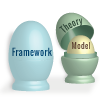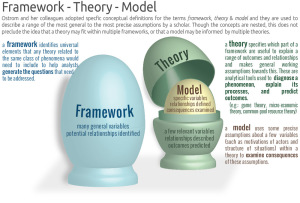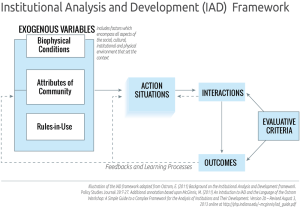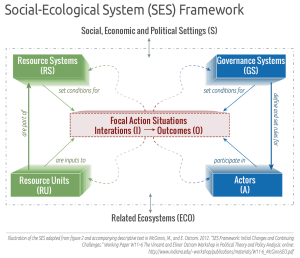
Water is embedded in landscapes that are altered by both natural and human processes. The way we use and manage a water resource impacts its characteristics and these impacts can cascade to related systems — there is an ongoing conversation within the water community that continues to express that water researchers cannot afford to ignore the potential impacts of governance, politics, and culture on their subject; just as bureaucrats, decision makers, and non-governmental actors who have stake in water cannot afford to be ignorant of the relevant natural and social science regarding water. A large body of research embraces the intersection between ecological systems and society. One of these approaches, the Socio-ecological Systems perspective, uses concepts from complex systems and acknowledges that the divide between ecosystems and human systems is largely arbitrary — changes in natural or human systems contribute feedbacks that alter each. A major contributor to this body of knowledge was Elinor Ostrom, through her refinement of frameworks for examining complex institutions and interactions with external systems. Her work embraced the complexity inherent to and contextual nature of common-pool resources.
The December 2013 issue of the Journal of Institutional Economics is dedicated to the memory of Elinor Ostrom. I entered the issue via an article on robustness of small-scale irrigation systems submitted by Marco Janssen and John. M. Anderies (Water Diplomacy RCN), but have been slowly working through other articles of interest.
Three frameworks (IAD, SES, Robustness) developed by Ostrom and numerous collaborators, are increasingly used in the analysis of institutional and policy design for managing common-pool resources and contributing to our expanding knowledge of sustainable development, design for resilient communities, and how we might manage resources in the face of unquantifiable uncertainties. These frameworks are known to many political scientists, economists, geographers and ecologists as tools for characterizing and focusing research questions within interdependent dynamic systems. However, not everyone who works within such systems employs a framework perspective or has familiarity with these or other common frameworks. Frameworks are tools for representing or characterizing the many-parts of real, complex problems, and having some options for representing a problem within its context may be useful for a broad range of water professionals who consider how policy and management questions connect to research questions that cut across social and natural domains.
Unfortunately, these tools come with a significant learning curve. Frameworks have specific term definitions and grammatical language. They are presented as simple figures, but represent complex ideas. Some frameworks are built upon other frameworks, and carry with them aspects of that earlier work. This means that learning how a framework was applied to a specific analysis of interest or how to start using some framework to represent a current problem of interest is time intensive and intellectually demanding. In the rest of this post, I’ve attempted to provide a quick introduction to the language of frameworks, the relationship between the IAD, SES, and Robustness Frameworks, and include a few of the most helpful resources for digging deeper into these frameworks and their use.
Defining Frameworks
A common challenge when working in an interdisciplinary setting is that academic disciplines have their own vocabulary, and there are many words with specific meaning in one setting, and different implications in another. In the context of the Ostrom Workshop, framework describes the most general set of variables and broadest assumptions when examining a setting (made of one or more systems). Frameworks provide a way for an analyst to describe the parts of this setting and what general interactions and relationships may exist. A framework can inform an analyst’s evaluation of parts as the analyst learns more about how the parts relate to each other. A framework does not assume the nature of relationships and is not prescriptive. Further refinement, additional details and assumptions about the nature of relationships and variables, moves into the territory of theories, and as a specific theory is refined to include predictive assumptions, analysts may construct models that make more precise assumptions to examine the application of a theory to specific situations, outcomes, and structures.

Frameworks, theories, and models are conceptualized as nested representations of a set of variables and their connections, from the most general to the very specific. Click for larger image.
Generally speaking, frameworks provide a template that can be used to acknowledge and organize the elements of related systems of interest to support further investigation into these systems. Frameworks can help illustrate the connected parts and potential interdependencies between broad system variables. This is useful when a problem or question is embedded in a complex network of related variables and addressing the question requires consideration of the complexity of the problem’s setting. Specific frameworks have applicability to a limited range of research questions, and selecting the appropriate framework for representing the relevant setting for that question can be challenging.
Frameworks representing complex and contextual phenomena are, themselves, complex and require significant introduction to understand their intended use. There are many frameworks for examining social-ecological systems (see Binder et al, 2013 for a review of ten, with discussion of both analysis- and action-oriented frameworks and framework selection). A system such as a fishery, irrigation scheme or river basin can be represented using multiple frameworks, and a researcher may find that some frameworks are better for initiating specific types of questions (e.g. policy implication questions vs. questions about improving resilience or robustness of the system to certain shocks).
Diving into the literature on frameworks can quickly lead to “framework overload.” Frameworks are often presented as simple graphics, and though these figures represent significant analysis and revision of ideas contributed by multiple collaborators over time, these graphic representations of the body of work are often limited by the reproducibility of complex collaborative ideas as two-dimensional drawings. In the sections below, I’ve attempted provide a general introduction to IAD, SES and Robustness frameworks; the latter two frameworks can be helpful for characterizing water problems. The resources below each of these overviews provide greater depth a jumping off point for anyone interested in learning more about the purpose, development and application of these particular frameworks; and, certainly are not indicative of the range of information available.
Resource
- Binder, C. R., J. Hinkel, P. W. G. Bots, and C. Pahl-Wostl. 2013. Comparison of frameworks for analyzing social-ecological systems. Ecology and Society 18(4): 26.
Institutional Analysis and Development (IAD) Framework
The IAD framework was initially developed as a tool to help researchers structure the analytical tasks involved in understanding the complexity of an institution (used broadly to incorporate the shared rules, strategies, and norms implemented by individuals within or across organizations). This framework enables researchers to analyze diversely structured markets, hierarchies, common-property regimes and local public economies using a common set of universal components.
A key feature of this framework was the introduction of the action arena and the definition of an “action situation” in which participants acting as individuals or as representatives of their organization observe information, select actions, interact, and realize outcomes from the interactions. The framework further outlines the nature of the actors, resources, rules and options within action situations
This is not tied to single type of policy situation, and while it was used successfully in conjunction with investigations into resource management, ecologists criticized the IAD for treating the biophysical context as an external force, and not explicitly recognizing that there is a degree of control over a natural resource via the management policies and monitoring of the resource. I’ve included this framework here only to provide a little background on the origins of the SES framework. Specific language used in the IAD Framework is also used by the SES Framework.
Resources
- Ostrom, Elinor. 2005. Understanding Institutional Diversity. Princeton, NJ: Princeton University Press.
- Ostrom, Elinor. 2007. “Institutional Rational Choice: An Assessment of the Institutional Analysis and Development Framework.” In Sabatier, Paul, ed. 2007. Theories of the Policy Process. Boulder, CO: Westview Press.
- Michael D. McGinnis. 2011. “An Introduction to IAD and the Language of the Ostrom Workshop: A Simple Guide to a Complex Framework,” Policy Studies Journal 39 (1) , 163-177. Version 2b (expanded and revised draft) of this article (draft) is available: http://php.indiana.edu/~mcginnis/iad_guide.pdf
Social-Ecological System (SES) Framework
A socio-ecological system contains an ecological system that is intricately linked with social systems in such a way that there are interdependencies between the bio-geo-physical system and the actors within the social system(s). The SES Framework grew from the IAD framework and the need to provide coherent analysis of these complex, nested, multi-resource systems operating over a number of scales. At the first tier, this framework distinguishes between Resource Systems, Resource Units, Governance Systems, Actors, and the Interactions and Outcomes within action situations. Each of these variables is a coarse heading for more specific variables that increase the level of detail for how the system is described and which inputs and conditions impact specific interactions and outcomes at the center of the framework. These interactions and outcomes provide feedbacks that can impact any of the other variables.
In the SES representation, the Social, Economic, and Political Settings and Related Ecosystems are treated as exogenous drivers that impact the environment in which the Resource and Systems of interest, Governance Systems and Actors interact, further contributing to the complexity of a problem. Within an SES, there may be multiple instances of each top tier element: e.g. the same representation of an SES may have multiple relevant resource systems or multiple-governance systems that need be represented parallel to each other (not hierarchically). Within each instance of a top-tier variable, certain sub-variables (“tier-two”) may be included. These tier-two variables clarify the properties of the variable (see illustration, below to the left).

Each top tier variable shown in the SES framework can have multiple instances, and each variable has associated sub-variables (“tier-two”). This illustration includes these tier-two variables with their respective top-tier variables. Click for larger view.
The visual representation of the SES Framework is deceptively simple, as each variable can have multiple instances, and each instance contains multiple sub-variables. The solid arrows defining inputs and direct connections between variables can connect multiple top-tier variables. For instance, multiple Resource Systems could contribute to setting conditions for the same Focal Action Situation. Additionally, a specific feedback from an Action Situation may impact a subset of the relevant Actors.
The representation explicitly includes feedbacks that occur due to interactions of any variables within an action situation, and the bounding box helps to suggest the feedback that may occur between variables subject to social or ecological settings outside of the action situation(s) of interest, but does not represent the feedbacks that occur within each variable (e.g. natural hydrologic variable within a river basin).
Resources
- Ostrom, E. (2009) A General Framework for Analyzing Sustainability of Social-Ecological Systems. Science 24:325 (5939), 419-422. http://www.sciencemag.org/content/325/5939/419.short
- McGinnis, M., and E. Ostrom. 2012. ““SES Framework: Initial Changes and Continuing Challenges.” Working Paper W11–6 The Vincent and Elinor Ostrom Workshop in Political Theory and Policy Analysis: online: http://www.indiana.edu/~workshop/publications/materials/W11-6_McGinnisEO.pdf
Robustness Framework
While the SES Framework can be used to parse an SES to identify component elements, their characteristics and interactions between elements, it doesn’t provide a systematic way to study the feedbacks and dynamics within the SES. The Robustness Framework grew out of the question “what makes social-ecological systems robust?” This question itself is somewhat loaded — robust in respects to what types of system shocks? how do we identify the cost-benefit trade-offs in evaluating robustness of a particular system for these types of shocks? how do we define the system and the characteristics that should be maintained? How does the collapse of a system component (such as a single fishery within a larger system of resources, infrastructure, and relevant actors) relate to the robustness of the total system and its other social and resource components? How do we design for robustness?

The Robustness Framework, developed by Anderies, Janssen and Ostrom, focusesinteractions within an SES that important in describing the robustness of the system from an institutional perspective. Click for larger view.
The Robustness Framework is a minimal representation of an SES that focuses on the interactions within an SES that important in describing the robustness of the system from an institutional perspective. The elements at the core of the framework include the resource and related physical and social infrastructure, and the people and organizations who use and provide the structure, and sources of external disturbance to the system from either biophysical sources (link 7) that impact resources or infrastructure or socioeconomic changes (link 8) that impact the providers of infrastructure or those who use the resource. Use of this framework focuses on characterizing what events, relationships, or dependencies occur at the numbered links. For example: between public infrastructure and those who provide it (link 3) is there appropriate capitalization and oversight for building an infrastructure element? how is maintenance or monitoring and enforcing the rules for using infrastructure implemented and coordinated? These elements and linkages were specifically chosen to help widen the range of strategic interactions within a system that can impact its ability to respond to disturbance. Additionally, each link is multifaceted, and much like in the SES representation, there may be multiple instances and characterizations of the relationships between these linked elements.
This framework may be useful for questions that arise when feedbacks that impact biophysical aspects of a system occur at increased rates — when the rate of change for a resource and access to (or need for) that resource approach the timescale of the the policy processes that determine how we allocate, access, and develop that resource, and this concept and related questions are discussed extensively in Anderies & Janssen (2013).
Resources
- Anderies, J. M., M. A. Janssen, and E. Ostrom. 2004. A framework to analyze the robustness of social-ecological systems from an institutional perspective. Ecology and Society 9(1): 18. available online: http://www.ecologyandsociety.org/vol9/iss1/art18/
- Anderies, J. M. and Janssen, M. A. (2013), Robustness of Social-Ecological Systems: Implications for Public Policy. Policy Studies Journal, 41: 513–536.
A Few Final Thoughts
Frameworks are a tool for examining the parts of a system or network that relate to a problem or question. Representing problems in their context can help identify where different expertise may be needed, help identify where “weak links” may contribute to the intensification of a problem or potential collapse of a system element or even just help in the process of communicating the intricate nature or complexity of a problem to a wider audience. However, representing a problem in a useful way is just one more small step toward actually addressing that problem.
I like the systematic way the SES framework can be applied at a purely conceptual, initial level to start to “unpack” the components of a “big” question or problem that impacts natural resource management. When attempting to describe a problem that impacts a resource system, I find myself organizing my information (and considering what other information I may need) in terms of the SES tier-one and two-variables. While this is not an extensive or formal use of the framework, it provides me with a starting point for thinking about a complex issue and organizing how I might describe the issue and its components to others. What other tools for representing real problems or the complex settings in which problems occur are particularly useful to you? What strategies and tools for moving from a broad representation of a problem context to more refined questions or actions should water researchers be aware of or trained to use?


